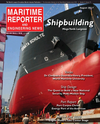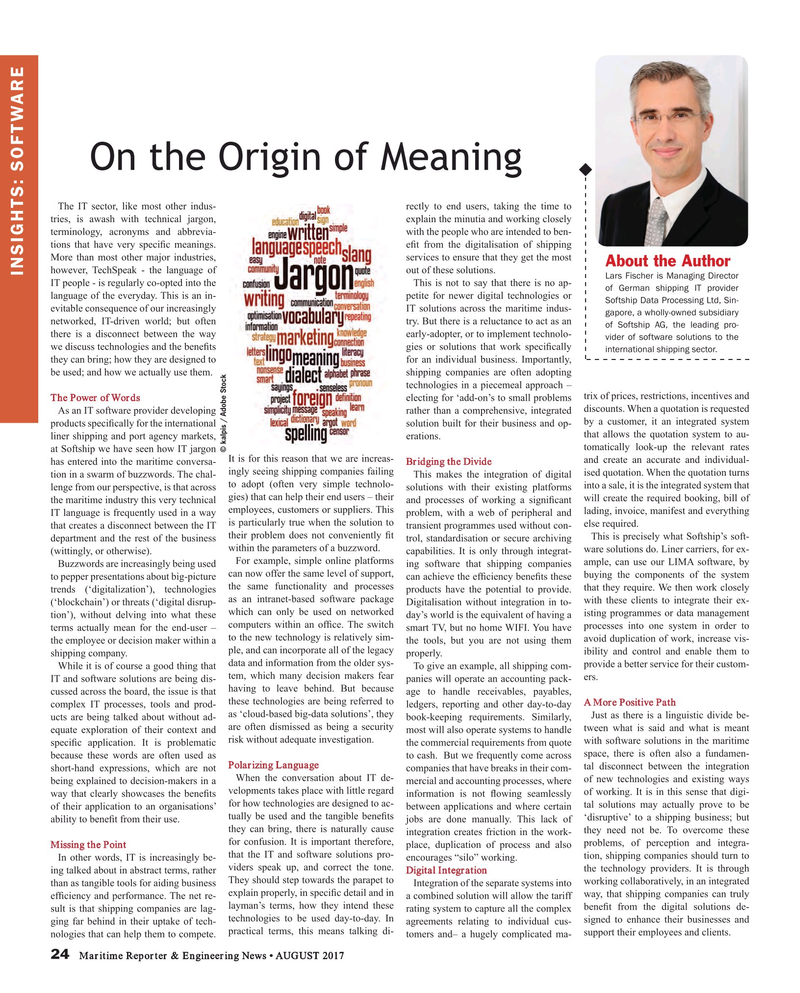
Page 24: of Maritime Reporter Magazine (August 2017)
The Shipyard Edition
Read this page in Pdf, Flash or Html5 edition of August 2017 Maritime Reporter Magazine
On the Origin of Meaning
The IT sector, like most other indus- rectly to end users, taking the time to tries, is awash with technical jargon, explain the minutia and working closely terminology, acronyms and abbrevia- with the people who are intended to ben- tions that have very speci? c meanings. e? t from the digitalisation of shipping
More than most other major industries, services to ensure that they get the most
About the Author however, TechSpeak - the language of out of these solutions.
INSIGHTS: SOFTWARE
Lars Fischer is Managing Director
IT people - is regularly co-opted into the This is not to say that there is no ap- of German shipping IT provider language of the everyday. This is an in- petite for newer digital technologies or
Softship Data Processing Ltd, Sin- evitable consequence of our increasingly IT solutions across the maritime indus- gapore, a wholly-owned subsidiary networked, IT-driven world; but often try. But there is a reluctance to act as an of Softship AG, the leading pro- there is a disconnect between the way early-adopter, or to implement technolo- vider of software solutions to the we discuss technologies and the bene? ts gies or solutions that work speci? cally international shipping sector. they can bring; how they are designed to for an individual business. Importantly, be used; and how we actually use them. shipping companies are often adopting technologies in a piecemeal approach – electing for ‘add-on’s to small problems trix of prices, restrictions, incentives and
The Power of Words rather than a comprehensive, integrated discounts. When a quotation is requested
As an IT software provider developing by a customer, it an integrated system products speci? cally for the international solution built for their business and op- that allows the quotation system to au- liner shipping and port agency markets, erations. tomatically look-up the relevant rates at Softship we have seen how IT jargon © kalpis / Adobe Stock
It is for this reason that we are increas- and create an accurate and individual- has entered into the maritime conversa- Bridging the Divide ingly seeing shipping companies failing
This makes the integration of digital ised quotation. When the quotation turns tion in a swarm of buzzwords. The chal- to adopt (often very simple technolo- solutions with their existing platforms into a sale, it is the integrated system that lenge from our perspective, is that across the maritime industry this very technical gies) that can help their end users – their and processes of working a signi? cant will create the required booking, bill of
IT language is frequently used in a way employees, customers or suppliers. This problem, with a web of peripheral and lading, invoice, manifest and everything else required. that creates a disconnect between the IT is particularly true when the solution to transient programmes used without con-
This is precisely what Softship’s soft- department and the rest of the business their problem does not conveniently ? t trol, standardisation or secure archiving within the parameters of a buzzword. ware solutions do. Liner carriers, for ex- (wittingly, or otherwise). capabilities. It is only through integrat-
For example, simple online platforms ing software that shipping companies ample, can use our LIMA software, by
Buzzwords are increasingly being used can now offer the same level of support, can achieve the ef? ciency bene? ts these buying the components of the system to pepper presentations about big-picture trends (‘digitalization’), technologies the same functionality and processes products have the potential to provide. that they require. We then work closely with these clients to integrate their ex- (‘blockchain’) or threats (‘digital disrup- as an intranet-based software package Digitalisation without integration in to- tion’), without delving into what these which can only be used on networked day’s world is the equivalent of having a isting programmes or data management terms actually mean for the end-user – computers within an of? ce. The switch smart TV, but no home WIFI. You have processes into one system in order to to the new technology is relatively sim- the tools, but you are not using them avoid duplication of work, increase vis- the employee or decision maker within a ple, and can incorporate all of the legacy ibility and control and enable them to shipping company. properly. provide a better service for their custom-
To give an example, all shipping com-
While it is of course a good thing that data and information from the older sys- ers.
IT and software solutions are being dis- tem, which many decision makers fear panies will operate an accounting pack- cussed across the board, the issue is that having to leave behind. But because age to handle receivables, payables, these technologies are being referred to ledgers, reporting and other day-to-day A More Positive Path complex IT processes, tools and prod-
Just as there is a linguistic divide be- ucts are being talked about without ad- as ‘cloud-based big-data solutions’, they book-keeping requirements. Similarly, equate exploration of their context and are often dismissed as being a security most will also operate systems to handle tween what is said and what is meant the commercial requirements from quote with software solutions in the maritime speci? c application. It is problematic risk without adequate investigation.
to cash. But we frequently come across space, there is often also a fundamen- because these words are often used as tal disconnect between the integration companies that have breaks in their com- short-hand expressions, which are not Polarizing Language
When the conversation about IT de- of new technologies and existing ways being explained to decision-makers in a mercial and accounting processes, where way that clearly showcases the bene? ts velopments takes place with little regard information is not ? owing seamlessly of working. It is in this sense that digi- between applications and where certain tal solutions may actually prove to be of their application to an organisations’ for how technologies are designed to ac- tually be used and the tangible bene? ts jobs are done manually. This lack of ‘disruptive’ to a shipping business; but ability to bene? t from their use. they can bring, there is naturally cause integration creates friction in the work- they need not be. To overcome these for confusion. It is important therefore, place, duplication of process and also problems, of perception and integra-
Missing the Point that the IT and software solutions pro- tion, shipping companies should turn to
In other words, IT is increasingly be- encourages “silo” working. the technology providers. It is through ing talked about in abstract terms, rather viders speak up, and correct the tone. Digital Integration
They should step towards the parapet to working collaboratively, in an integrated than as tangible tools for aiding business Integration of the separate systems into explain properly, in speci? c detail and in a combined solution will allow the tariff way, that shipping companies can truly ef? ciency and performance. The net re- layman’s terms, how they intend these rating system to capture all the complex bene? t from the digital solutions de- sult is that shipping companies are lag- signed to enhance their businesses and ging far behind in their uptake of tech- technologies to be used day-to-day. In agreements relating to individual cus- support their employees and clients.
tomers and– a hugely complicated ma- nologies that can help them to compete. practical terms, this means talking di- 24 Maritime Reporter & Engineering News • AUGUST 2017
MR #8 (18-25).indd 24 MR #8 (18-25).indd 24 8/4/2017 2:48:34 PM8/4/2017 2:48:34 PM

 23
23

 25
25
